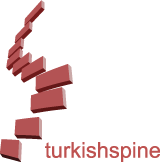ABSTRACT
Intradural disc herniation is rare. In elderly patients, particularly in cases with degeneration, as well as in cases with congenital or acquired anterior dural adhesion. 90% of them are located at the lumbar L4/5 level.
Lumbar intradural disc herniation was first reported in 1942 and to our current knowledge, 123 cases have been reported to date. We have reported an elderly patient with lumbar intradural disc herniation, as well as reviewed the literature order to explain its potential pathogenesis, natural course, differential diagnosis and treatment.
INTRODUCTION
Rupture of intervertebral disc (IVD) material into the intradural space is known to be rare(1,2). Intradural disc herniation (IDDH) occurs in 0.04% of all IVD cases, whereas 90% of them are located at the lumbar (L4/5) level(1,3). The extruded material of nucleus pulposus (NP) may be herniated bellow the degenerated annulus fibrosus (AF), the posterior longitudinal ligament (PLL) or the anterior wall of the dura, and may migrate intrathecally(2,4). Dandy reported two cases of cauda equina syndrome due to chordoma in 1929. Barr definitely demonstrated that these chordomas were fragments of degenerated disc in 1934 (2,5-7). Lumbar IDDH was first reported at 1942 and to our current knowledge, 123 cases are reported until today(8). Lumbar IDDH may cause signs and symtoms similar to transverse lesion of the cauda equina and can be mistaken as an intraspinal neoplasm(1,6,8). We have presented an elderly patient with lumbar IDDH, as well as reviewed the literature in order to explain its potential pathogenesis, natural course, differential diagnosis and treatment(1).
CASE REPORT
Seventy six years old male patient has been admitted to our clinic with lumboischialgia in L5 dermatome at 2020. Left leg knee extension and ankle dorsiflexion was found to be weak. Lumbar magnetic resonance imaging (MRI) scan revealed spinal stenosis at the level of L3/4, L4/5 and extruded IVD at the L4/5 level. We performed decompression of both levels and nucleotomy at L4/5 level. Weakness has resolved and the patient has been discharged from the hospital on the 5th postoperative day. At the one month follow up examination, there were no neurological deficits. Pathological examination revealed a degenerated yellow-white cartilage tissue of elastic consistence. He has been re-admitted to our clinic in 18/02/2022 again with ischialgia in L5 dermatom, as well as hypesthesia and ankle dorsiflexion weakness of his left foot. Lumbar MRI scan revealed inferiorly migrating extruded disc fragment at the L4/5 level (Figure 1).
We extended the hemilaminectomy using the old postoperative incision scar, cleared epidural scar tissue and performed re-nucleotomy at L4/5 level. Intraoperative removed disc material and MRI scans were inconsistent. Expected big, free disc sequester was not found. Level was checked again with flouroscopy and ultrasonography (USG) was performed, where both were found to be normal. Nevertheless complaints of the patient receded rapidly during the postoperative period and he has been discharged on the 5th postoperative day. Patological examination of removed material revealed degenerated hyalinised fibrocartilage tissue.
On the 7th postoperative day the patient came again with incontinence and weakness of his left leg. We have considered that the reason might be an IDDH. Contrast enhanced lumbar MRI scan has been performed and revealed extruded fragment with dimensions of 24x18x14 mm, at the same level and was reported as peripherally contrast enhanced intradural mass (Figure 2). We performed surgery to remove the mass. Intraoperatively it was adherent to the adjacent nerve roots and vessels. We could remove the mass totally. A dural defect or postoperativer Lymphleckagen (PLL) tear was not detected (Figure 3). Patients complaints receded postoperatively and he was discharged on the 7th postoperative day. Pathological examination revealed a yellow beige colored cartilage tissue with degeneration, necrosis and elastic consistence. Signs of neoplasm were not observed.
DISCUSSION
Lumbal IDDH is a very rare phenomenon of a degenerative lumbar lesion in the elderly population(1).
IVD consists of shock absorbing semifluid, very elastic chorda dorsalis remnant, strong AF rich in collagene at the outer part, as well as an end plate at the adjecent vertebral body(9,10). At the most outer part PLL is attached from C2 level up to the sacrum along the posterior aspect of the vertebral bodies(11-13). Stability of the vertebras depend on its static and dynamic structure(12). 55-70% of longitudinal and tortional forces on the vertebra reach to the disc, whereas 30-45% reach to the facet. The direction of these forces can be changed and can expand all to the transverse surface(10). PLL restricts flexion, posterior herniation of the disc and transform the forces to different sides(10,12,13). However with age, degeneration occurs and these tasks can not be performed(5,9,10).
The PLL is strongest in the midline(10): Therefore lumbar disc herniation occur mostly at one side. A herniated disc fragment will rarely be centraly extruded, mostly herniation can be localized subligamentous, transligamentous or retroligamentous(1,5). Migrated fragment as a term is used for a disc, settled in another area apart from intervertebral space(2,14). Pathogenesis and natural course of IDDH is still unclear(1). The formation of this phenomenon depends on extruded fragment of NP, and tear of AF, PLL and anterior spinal dura mater(8,15,16).
Gelatinous structure of NP transforms into fibrous cartilage, whereas water consistence reduces from 90% to 70%(5). Also vessels at the central area of IVD obliterate and ossify with age(10). Adhesion occurs between AF, PLL and dura(1,4). This adhesion and degenerative changes progress with increase in age(4,9,10). Therefore the force coming here can not be transferred to enviromental tissue and is delivered to dura mater(12). Reduced elasticity and flexibility in this area may result with tear of dura mater(10,12,15). In elder population spontaneous adhesions between AF, PLL and ventral spinal dura prevent lateral migration of disc fragment and facilitate penetration of the tethered dura(4,5,8,13). This adhesion becomes weaker and may also ocur following repeated minor trauma, prior to surgery, chronic inflammation, osteopathies, degenerated herniated NP (HNP), acute or chronic compression(8,16-18). Penning and Wilmink(3) demonstrated weakness and tear at this area by myelography, Hodge et al.(19) showed it by metrizamide enhancement computed tomography (CT). Sharma et al.(16) believed that when the spine sudenly bears external force when patient sneezed, pressure in the IVD increases sharply and cause IDDH. Lee and Fairholm(15) stated that processes like osteophytes and extruded IVD cause long-term mechanic compression and result with thinner and fragile dura mater, facilitating penetration of the dural sac. Dura mater and PLL are close at the L4/5 level respectfully and IDDH is most frequently involved at this level(1,16). Extreme strain occur at this level by flexion and extension(6). Rathod et al.(8) observed congenital narrowing of the spinal canal with less epidural space and congenital adhesion between PLL and dura mater in 8 of 40 cadaver. Blikra(4) demonstrated firm anatomic adhesion between anterior dural wall and PLL at level L4/5.
All of these processes were present in our case in addition to deep curetage of PLL in order to remove the fragments at the middle part and to prevent recidive disc which may contribute to dural tear and penetration of the fragment. CT scans were shown to be insufficient in demonstrating IDDH(1,16), whereas contrast-enhanced MRI scans can show sequestered fragment, intradural extension and lateral restenosis(8).
Contrast enhacement MRI scans are crucial for both diagnosis and differentiation of a HNP from disc space infection and tumor(2,6,7,19). Hodge et al.(19) demonstrated IDDH rupture at the preoperative period by metrizamide enhancement spinal CT scanning. Still it is difficult to make an exact diagnosis. Wasserstrom et al.(7) reported that IDDH mimics an intra dural tumor.
We operated on our case 2 years ago with diagnosis of left subligamentous disc herniation of the L4/5 level and spinal stenosis of the L3/4 level. Two years later, numbness and weakness started at the left leg. MRI scan revealed a disc fragment extruding to the left of L4/5 level, as well as spinal stenosis. We have extended the left laminectomy and cleared the space, however the removed disc material and the preoperative MRI was incompatible(1,8). Intraoperative palpation of dura through laminectomy defect did not reveal rigidity. We did not detect pathology of the USG in this area(1). His complaints receded postoperatively but we were already in doubt about the presence of IDDH. Although, jugular vein compression test (Naffziger test) was positive(6). Because of the patients persistence, on the 5th postoperative day he has been discharged. Rathod et al.(8) reported that while treating lumbar disc disease, the possiblity of an IDDH should be kept in mind, especially because it is mostly diagnosed intraoperatively as a surprise.
Ge et al.(1) states that after the observation of an intraoperative disc fragment, if additional fragment can not be detected at the epidural area and if the observed material is not in accordance with preoperative MRI, PLL rupture, ventral dura tear and IDDH should be considered(6,8). The patient underwent contrast enhancement MRI scan on the 7th postoperative day because of weakness of the left leg and urinary incontinence. Radiologists reported that separated epidural fragment was still at the same area but was found to be smaller. We discussed that there was no mass detected at the epidural space intraoperatively, and that it could only be an intradural mass. Therefore after revaluation of MRI scans, intradural mass was reported at the L4/5 level (Figure 2).
We opened the dura and completely removed the yellow white, fragile, bleeding, mass resembling macerated dermoid tumor which was pushed towards the right side, and attached to the nerve root, as well as the vascular structures. We did not detect a tear at the anterior wall of dura. Pathological findings revealed cartilage tissue with degenerative and necrotic tissue. No signs of malignancy were found. Wasserstrom et al.(7) also reported that his case resembled intradural tumor. Ge et al.(1) detected ruptured PLL and old tear of the ventral dura, a mass similar to NP tissue in his case with IDDH. We did not detect a tear. IDDH can enhance contrast because it is surrounded by vascular tissue rich in blood vessels, which is considered to be the most specific. Furthermore appearance of macrophage infilitration may mislead us(1,8,20).
As a result, in elderly patients with degeneration, if contrast enhanced MRI is not compatible with intraoperative findings, IDDH should be considered, even though it might not be detected by palpation or USG.



